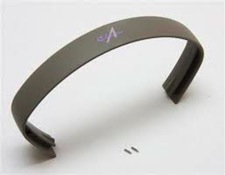It’s the time of year for saving money!

Several weeks ago I broke the headband on my 19-year-old Stax Lambda
Nova Classic headphones. It was due to go. Two years ago I replaced the “set
screw” that holds in the right side transducer on the headband with a small
brad because the original part had fallen out and disappeared. That bit of redneck
engineering had held up for a couple of years with regular repeated
re-super-gluing. But finally the small often-glued crack at the screw-hole
expanded and the section below the screw hole broke off completely. No amount
of superglue, epoxy or liquid metal would put it back together again. It was
time for a new headband.
Fortunately Stax still sells replacement headbands for the Stax
Nova. It’s a part that is still used in the current-production SR-303 and SR-307. So for
the princely sum of $40 plus $13 shipping I got a replacement headband. Don’t
get me wrong, I’m not bitching about the price. Considering the custom nature
of the part, I don’t feel as if $40 is exploitive.
About fifteen minutes after the new headband arrived from Stax
I had it installed on my Lambda Nova Classics. That’s when the surprises began.
My old Stax Lambda Nova Classics sounded different with the new headband. How
do I know for sure? I compared it with my pair of original high-voltage Lambda
Pro headphones.
During the past couple of months I’ve been doing a lot of A/B
comparisons between the original Lambda Pros and the Lambda Nova Classic
headphones. These listening sessions were principally to compare different Stax
headphone amplifiers, but obviously I had ample time to compare the differences
between these two Stax models.

With its original 19-year-old headband the Novas had slightly
more bass extension than the Pros – emphasis on the word “slightly.” In most
other respects such as soundstage, upper frequency extension, and dynamic
acuity, the two earphones were very similar. With the new headband the Nova’s gained
not only bass extension, but also they gained in midrange presence and dynamic
precision. The Nova’s overall sound also gained immediacy, transient speed and
micro-dynamic contrast. How could all these sonic changes be a result of the
headband? Two words – clamping force.
It probably happened gradually over the course of the last
nearly two decades – the plastic used in the original Nova headband had gotten
softer and less springy. The result was the original headband no longer pushed
the earpads as tightly onto my head. This lower clamping force reduced the bass
and the overall immediacy of the Nova’s because the stator’s surface was
further way from ears. With the new headband the Nova’s driver was closer to my
ears and the seal around my ears was better.
Replacing the Stax Nova headband reminded me of the feeling
when I’ve replaced the tires on my Subaru (which due to mountain roads happens
every 15K or so). It’s that “new car”
feel, which was just as much new tires as new car.

I suppose I shouldn’t really be surprised. After all a
headphone’s fit is as critical to its performance as a room’s acoustics are to
the final sound of a loudspeaker. Improve the fit, and a headphone’s sound will
improve as well. In the case of my Stax Lambda Nova Classic headphones, getting
back to what was closer to their original performance level was a simple as
replacing their headband.
I’m tempted to replace the headband for my original Lambda Pro
headphones. Even though the original looks fine, my time with the Nova Classics
has convinced me how much a properly performing headband contributes to the overall sound of a classic Stax Lambda headphone.





